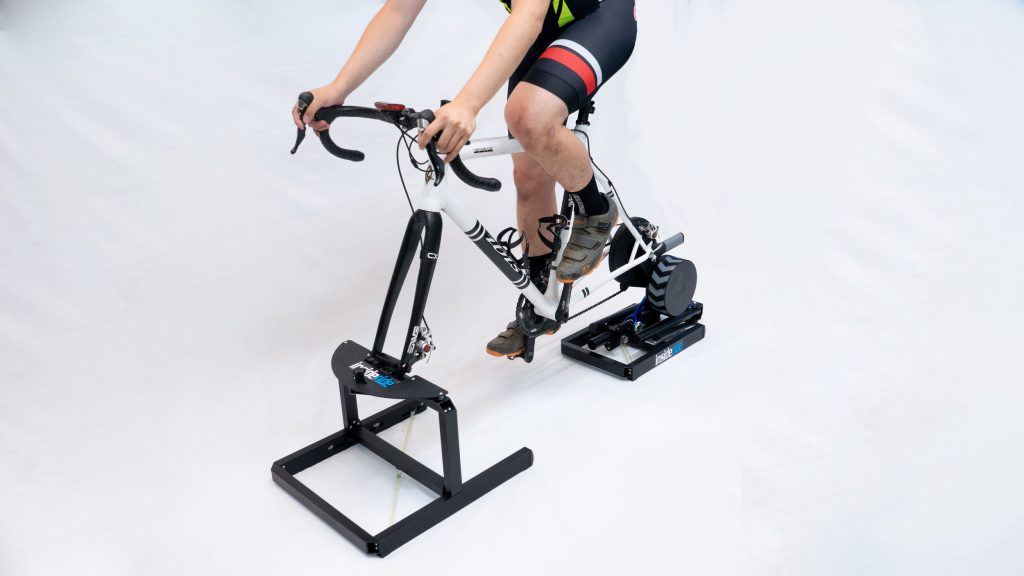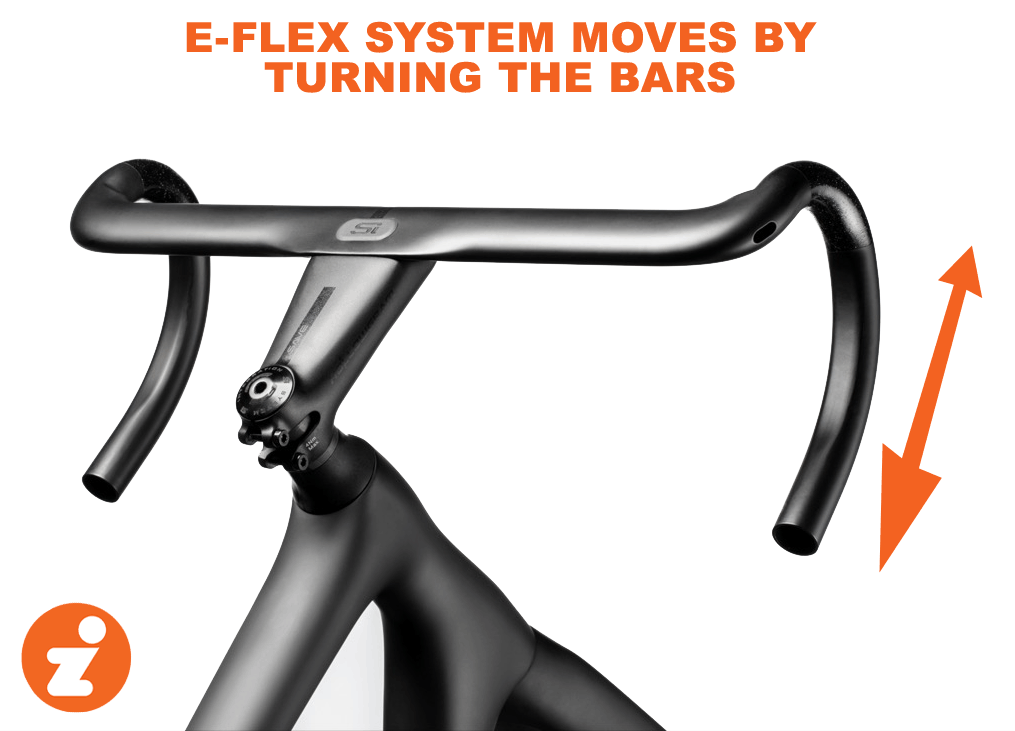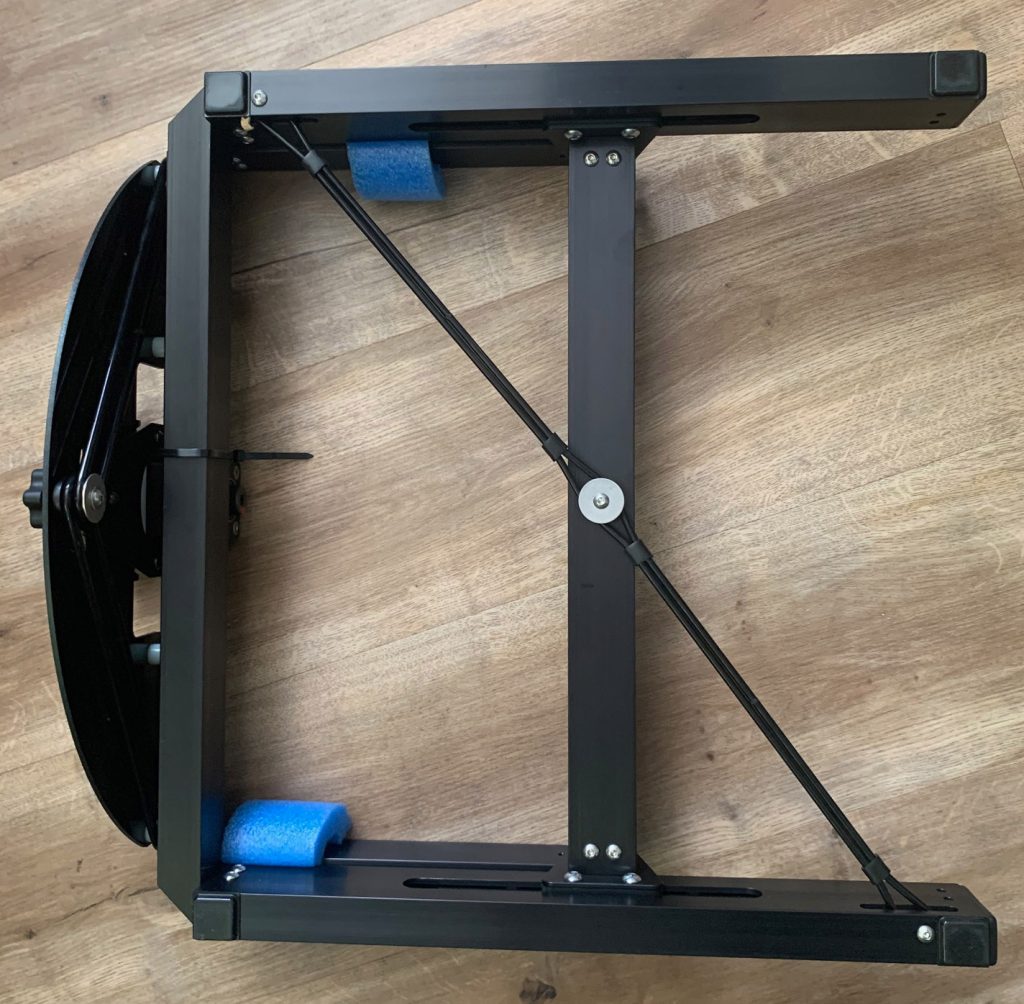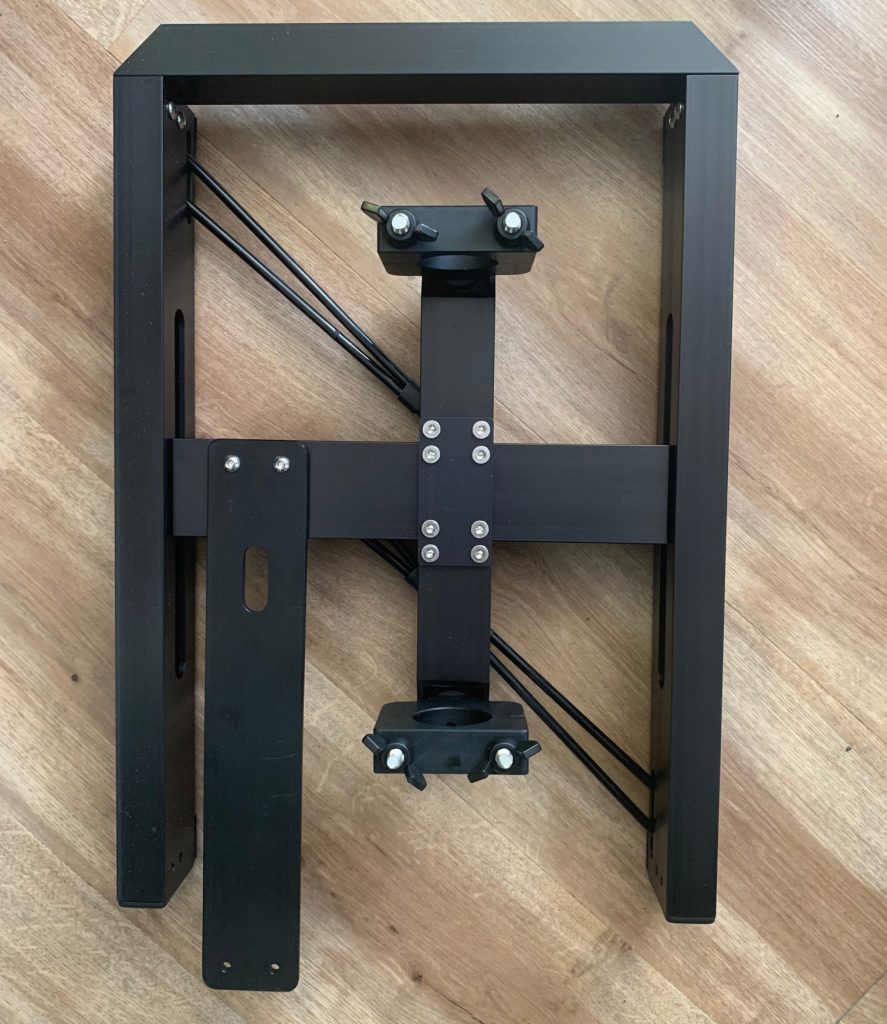USA-based InsideRide has been making rollers since 2005, and many Zwifters love their e-motion rollers. But I’ve had my eye on a different InsideRide product for months: the E-FLEX System.
This is a different sort of “rocker plate” in that it’s not a plate at all. It’s two pieces of hardware (one for the front of your bike, and one for the back) which together give you fore/aft as well as side-to-side motion abilities. InsideRide thinks it’s the next evolution of the rocker plate – but we’ll get more into that later.
I reached out to InsideRide a few times about getting a review E-FLEX unit, but they were always out of stock. The E-FLEX has been on the market for a year or more, but availability has been a challenge – they seem to sell out quickly! Finally I asked at the right time, and they shipped one over.
How It Works
The E-FLEX system consists of two pieces:
- At the back of your bike you have a platform that attaches to your trainer and allows it to move forward and backward as well as tilt left and right.
- Your front forks attach to a version of InsideRide’s Floating Fork Stand, a product also available for attachment to their rollers. This stand lets your front forks turn left and right (around 30 degress of motion, which will tilt your bike around 6 degrees) while also moving forward and backward.
It’s a system completely unlike any other rocker/motion system I’ve tested (and I’ve tested quite a few). Let’s dig in…
Wahoo KICKR and Core Only
I should mention here at the start: the E-FLEX only comes in two flavors currently: one which supports all Wahoo KICKR versions, and one for Wahoo KICKR Core.
Setup
The two parts arrived together in one box, and upon removing them I was struck by how small they were. I’ve grown used to dealing with full-length rocker plates, and the E-FLEX units are much lighter and smaller.
Setting up the E-FLEX is a bit more involved than a typical rocker plate, but it’s not technically challenging or time-consuming, either.
To assemble the rear unit you’ll need to take the adjustable feet off the end of your two KICKR legs, as well as removing the foot at the end of the middle leg (Phillips screwdriver required). Then lower it to its lowest setting, fold in the legs, set it in the channel on the platform, and secure it by hand with the wingnuts.
No inflating suspension balls or adjusting the tilt. It just worked.
The floating fork stand needs a few Allen screws installed with the included Allen key, then you just mount your front forks to it. My Zwift bike uses a standard quick release, but the stand is also compatible out of the box with most 12mm thru-axle forks. Your levers could be a problem though – InsideRide says, “Thru axles with rigid or non-folding levers will not work and must be replaced with either a folding or rotatable lever, or an axle that uses a hex key to tighten. Does not fit 15mm thru axles without additional hardware. Contact us for more info.”
Once my KICKR was secured to the rear unit, and the front unit had been set up properly, I just attached my bike frame on both axles. Here’s what the E-FLEX looked like completely assembled:

The build quality of the entire system seemed fairly bomb-proof and stable. But how would it feel? Time for a test ride!
Watch My Demo Video
I put together this video after spending several hours with the E-FLEX. The video demonstrates how it all works while riding at a social pace, sprinting in the saddle, climbing out of the saddle, and sprinting out of the saddle.
How It Feels: Side-To-Side
Hopping onto my new setup and joining the C. Cadence roadies on Tempus Fugit, I was immediately struck by how different this setup felt from the rocker plates I’ve reviewed over the years (and use daily). After recently reviewing the full-motion Velocity Rocker Plate, I suppose I expected the E-FLEX to feel pretty similar. Both are full-motion systems, right?
But it felt different. Very different!
Here’s why it’s different: with rocker plates, generally your entire bike rocks back and forth without your handlebars turning at all. Getting the rocker plate to rock requires swinging the bars side-to-side, which tilts them along with the rest of your bike.
With the E-FLEX, your bike only tilts side to side if your handlebars turn. Everything is pivoting on your steerer tube. Turn the bars right, and your bike leans to the left. Turn them right, and you tilt left.
In fact, the floating fork stand includes a locking nut which prevents your forks from turning. If you tighten this down (which you can do while riding), it locks your bike into an upright position – no side to side tilting.
As I spun around Watopia and got acquainted with the motion of the E-FLEX, I found myself conflicted. I thought rocker plate motion was quite natural. Was I living a lie? Was this handlebar-turning motion more realistic and reflective of outdoor riding?
After putting in several hours and a few hundred virtual kilometers atop the E-FLEX setup, I’ve come to a conclusion: the E-FLEX design gets it half-right. And so does the rocker plate!
But they’re different halves. Let me explain…
When it comes to side-to-side motion, the E-FLEX requires you to turn your handlebars in order to tilt the rest of your bike. Rocker plates, in contrast, require you to tilt your handlebars in the same direction as the rest of your bike frame.

Which one is right? For me, the E-FLEX solution is best when you’re in the saddle. And the rocker plate system is best when you’re out of the saddle.
The E-FLEX’s tilting motion feels very natural when in the saddle. I quickly settled into a comfortable rhythm with the bars turning and my frame tilting ever so slightly as I rode in zone 2. As I ramped up the watts this motion would increase – just like outdoors. In fact, I can confidently say that this in-the-saddle motion is the most realistic I’ve felt from any setup I’ve ever tested.
I used the E-FLEX for my Zwift Academy Finish Line ride, and stayed seated throughout, putting in max efforts across three timed segments. Apparently it worked – I improved all my times substantially! (See the video here.)
But here’s the thing: I stayed in the saddle throughout my Finish Line ride because I couldn’t get comfortable with the out-of-the-saddle motion of the E-FLEX. When I’m hammering out of the saddle I need to be able to pull up on the bars, against my pedaling motion, and have the entire bike tilt. But pulling up doesn’t work on the E-FLEX… you need to pull back/push forward, turning the bars, to get your bike to tilt.
So I found out-of-the-saddle work frustrating with the E-FLEX. Despite spending a fair amount of time trying, I just couldn’t generate the power I typically can standing up. It was a frustrating feeling. And that’s why I think rocker plates do out-of-the-saddle movement better.
How It Feels: Fore/Aft
The E-FLEX unit really shines when it comes to fore/aft movement. Compared to the Velocity Rocker I recently reviewed, the motion of the E-FLEX is more natural, and it is also completely silent. Seriously!
The fore/aft movement is managed using what are essentially fancy rubber bands like you would use for resistance training. And the system seems to work very, very well. It would slide forward a bit when I got out of the saddle, slide back a bit when I sat down, and move ever so slightly forward and backward when I was hammering in a seated position.
In short, it moves the way it should, which results in a more natural and comfortable ride feel.
Stability
It’s worth noting that the E-FLEX setup is less stable than a standard rocker plate. Whereas most rocker plates are basically impossible to tilt over, the E-FLEX system definitely can be toppled and you might hit the deck if that happens.
A few different times in my rides, I found myself falling over with one or both of the E-FLEX units lifted off the ground on one side. I never actually went overboard, but the potential was there. It happened most often when I would sit up, hands off the bars, and wipe my face with a towel. This removed my stabilizing points but also effectively closed my eyes, removing the helpful visual input that would say “Eric, You’re falling over!”
The E-FLEX system is dampened so sublimely that, as you tilt over, it doesn’t get “tighter” – so you don’t feel that resistance that says “You’re reaching the edge of your tilt” like you would on a rocker plate. This is a credit to the E-FLEX’s design, but it’s also a double-edged sword.
I wouldn’t say the setup is dangerous in terms of stability, but you just need to know that you can topple your entire setup.
And just in case you’re wondering: the E-FLEX system will not work without the floating fork stand on the front. You can’t just attach your front wheel and enjoy the E-FLEX’s full range of movement. The reason is, the fork stand gives you left/right stability. Without it, you’ll just be flopping left to right… it’s impossible to stay upright. Trust me, I tried!
Pricing
The E-FLEX system is priced at $449+shipping, making it the most affordable full-motion setup on the market today. Buy it here >
Conclusions
Reviewing the E-FLEX system opened my eyes to the shortcomings of a standard rocker plate’s motion. Will there ever be a solution that incorporates the best of the E-FLEX and a rocker plate? We shall see.
Most Zwifters probably spend 90% or more of their time seated, and the E-FLEX system handles seated movement better than any other solution I’ve tested.
So I’d say InsideRide’s E-FLEX system is a highly recommended indoor movement solution, especially for those who simply want a bit of comfortable, natural motion and aren’t looking to get major frame movement in hard out of the saddle efforts.
For me personally, I want that big side to side out-of-the-saddle movement. So I’ll be sticking with a rocker plate for now, although I’ll be wishing it provided the superior seated motion of the E-FLEX.
Questions or Comments?
Post below!


